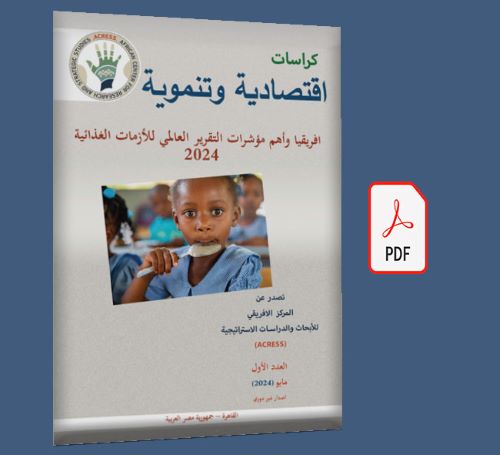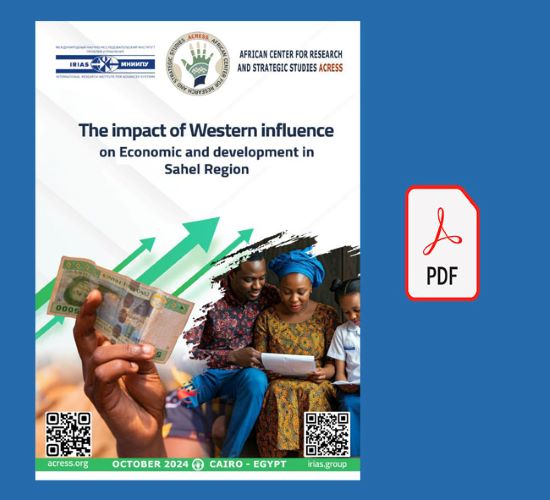
Report Preparation: Mrs. Merna Ahmed
Economic Researcher, African Center for Research and Strategic Studies (ACRESS)
Report Review: Dr. Ghada Fouad
Center Director, African Center for Research and Strategic Studies (ACRESS)
A food crisis in a country means that there is a severe shortage of food supplies and the population of that State suffers from extreme difficulty in accessing adequate food to meet their needs. This shortage of food supplies can be caused by several factors:
- Lack of local food supply: There may be a shortage of local food production as a result of poor weather conditions, lack of water resources, soil degradation or other impacts.
- Wars and political insecurity: conflicts, wars and armed conflicts within the country may lead to displacement of the population and destroy infrastructure, negatively affecting the ability to produce and distribute food. The Sudan and the Gaza Strip of Palestine are examples of States that have suffered severely from unusually high levels of acute food insecurity as a result of the recent escalation of conflicts inside them.
- Economic Shocks: The country may face economic shocks such as inflation, currency depreciation, high debt levels and higher energy prices, leading to an increase in the cost of production and an increase in food prices.
- Weather Extremes: Natural disasters such as earthquakes or hurricanes, floods destroying infrastructure, as well as environmental changes such as drought, soil degradation and water pollution affect agricultural production and reduce food's productive potential.
- Demographic Changes: Increasing population and changing food patterns put additional pressure on local food supplies, especially if the country is unable to keep pace with this growth by increasing agricultural production.[1]
- “Acute Food Insecurity”
The term of "Acute Food Insecurity" refers to a serious situation of inability to meet the basic food needs of individuals in a specific country or region, which puts the lives of the population at risk as a result of acute food shortages, deteriorating nutrition, and increased mortality. The Cases of Acute Food Insecurity is extremely worrying and requires an immediate and comprehensive response from the international community to prevent and mitigate humanitarian disasters according to the Food and Agriculture Organization of the United Nations (FAO).[2]
The Global Report on Food Crisis "GRFC" is the reference document for a comprehensive analysis of acute food insecurity at the global, regional and country levels. The global standard for measuring food insecurity is the Integrated Food Security Phase Classification (IPC) and the Cadre Harmonisé (CH) with five phases to classify food security, 'None/Minimal', 'Stressed', 'Crisis', 'Emergency', and 'Catastrophe' or 'Famine', which represents the most severe phase.[3]
The most important indicators of the Global Report on Food Crises (GRFC) on Africa:
New and escalating conflicts, extreme weather events and economic shocks have led to another year of increasing numbers of people suffering from worsening food crises with about 281.6 million people or 21.5% of the population analyzed facing high levels of acute food insecurity in 59 countries or territories. In addition to an increase in the number of people forced to flee their homes in 2023, More than 90 million people have been displaced, most of them internally displaced (64 million) and the rest are refugees, asylum-seekers and migrants.
Inside the Global Report on Food Crises "GRFC", the African continent was divided into four regions: Central and Southern Africa, East Africa, West Africa and the Sahel, and North Africa (Refugees).
It is clear from the report that the most affected region in terms of Integrated Food Security Phase Classification (IPC) and the Cadre Harmonisé (CH) according to the statistics of the Global Report on food crises for the years 2023 and 2024 is the East African region, as about 64.2 million people, or 24% of the population, face high levels of acute food insecurity, followed by the Central and Southern Africa region, where about 49.6 million people, or 21% of the total population, face high levels of food insecurity, followed by the West Africa and the Sahel region, which recorded about 44.3 million people, or 11% of the total population.
Regarding the number of displaced populations, the East African region has the largest number of displaced persons, as about 20.7 million forcibly displaced people were registered by the year 2023, most of them internally displaced people in Sudan, Ethiopia, South Sudan and Somalia. The Sudan recorded the largest case of internal displacement in the world by the end of 2023, Followed by Central and Southern Africa region, which recorded about 10.1 million forcibly displaced people, followed by the West Africa and the Sahel region, which recorded about 9.7 million forcibly displaced people.
Regarding the number of children affected by acute food insecurity, The West Africa and the Sahel region are the worst affected, as about 14.0 million children suffering from acute malnutrition, followed by East Africa, which has registered about 12.1 million children suffering from high levels of acute food insecurity, followed by Central and Southern Africa, which has registered about 3.9 million children.
It is estimated that the majority of children suffering from acute malnutrition live in Nigeria, with nearly 6 million children under the age of five suffering from acute malnutrition, of whom more than 1.6 million are severely affected, while the majority of pregnant and breastfeeding women who suffer from acute malnutrition live in the Democratic Republic of the Congo, their number is about 2.2 million pregnant and breastfeeding women.
The state of the Democratic Republic of the Congo in the region of Central and Southern Africa is the largest country in the world with the largest number of people suffering from high levels of food insecurity by the year 2023, their number has reached about 25.8 million people, or 25% of the total population, followed by the state of Nigeria, which recorded the largest number of people facing severe acute food insecurity in the West African and the Sahel region, and their number reached about 24.9 million people, or 13% of the total population, followed by the state of Sudan in the East African region, which recorded about 20.3 million people, or 42% of the total population.
The Sudan is considered the most affected country in the East African region as a result of the outbreak of conflicts and armed clashes inside the country, as the country recorded the largest annual deterioration in the “CH” classification since the outbreak of war in April 2023 because it included the largest population in the world facing emergency level (IPC Phase 4) according to statistics of the Global Report on Food Crisis 2024.
South Sudan is the world's largest country with the highest proportion of people suffering from high levels of acute food insecurity according to the report's statistics, with about 63% of the total population in South Sudan.
Four countries projected to be in “Catastrophe” (IPC Phase 5) across the African Continent, which are considered the most severe phases of acute food insecurity. They are South Sudan, Burkina Faso, Somalia, and Mali respectively. The two countries, Burkina Faso and Mali in the West African and the Sahel region, faced situations of “Catastrophe” due to disputes and conflicts existing in the region,as about 45,200 people were projected to be in “Catastrophe,” including 42,700 in Burkina Faso and about 2,500 people in Mali. These are considered the highest increases ever recorded in the history of the “CH” classification, while the other two countries, South Sudan and Somalia in the East African region, were projected to be in “Catastrophe” situations, as about 43,000 people in South Sudan and about 40,400 people in Somalia suffer from acute food insecurity.
Lesotho in the Central and Southern Africa region and Côte d'Ivoire in the West African and the Sahel region are the least affected countries in terms of phases of food insecurity, as no people were recorded in "phase 4" or "phase 5" of the Integrated Food Security Phase Classification in the latest statistics.
 ar
ar
 fr
fr



